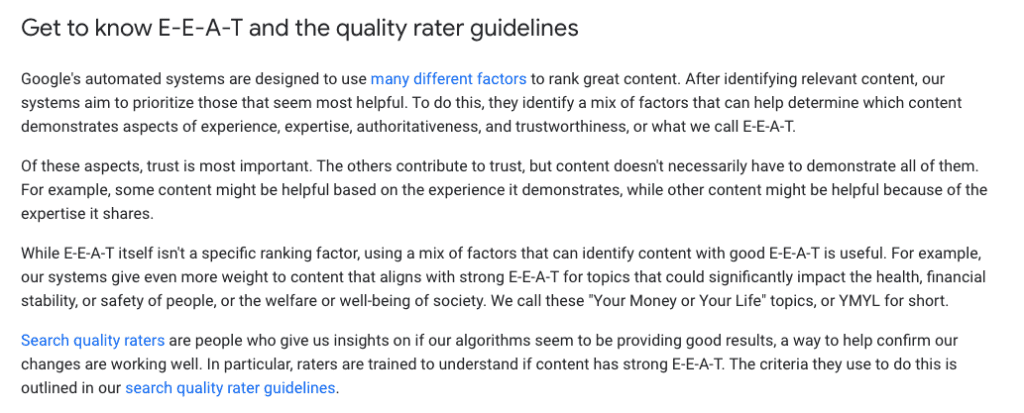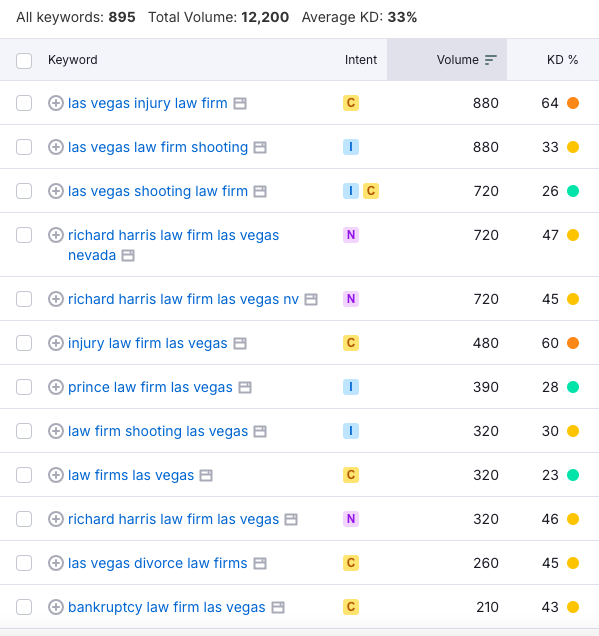You want to be at the top of the page? Get used to making consistent technical and creative work a habit. Law firms must maintain a strong online presence to attract new clients and stay competitive. Search engine optimization (SEO) is an essential tool for ensuring that potential clients can find your firm when searching for legal services. Organizing web pages for better navigation and usability is crucial, as it helps search engine crawlers effectively index them. However, Google’s SEO rules are constantly evolving, and staying compliant with these changes can be challenging, especially for law firms that must also adhere to strict industry regulations and ethical guidelines.
This blog will explore how law firms can stay compliant with Google’s ever-changing SEO rules while maintaining best practices for legal marketing. We’ll also examine the unique challenges law firms face when optimizing their websites for search engines, considering the sensitive and specialized nature of legal content.

Understanding Google’s Ever-Changing Search Engine Optimization Rules
Google’s primary goal is to provide its users with the most relevant, trustworthy, and high-quality content possible. To achieve this, the company continually updates its search algorithm to better rank websites based on their relevance, authority, and user experience. These updates can significantly impact a law firm’s SEO strategy, and failure to adapt can result in decreased visibility and traffic.
Google Analytics is a valuable tool for analyzing search performance and user behavior on websites. It helps track website traffic, understand visitor origins, and measure user engagement through metrics like bounce rates, which are crucial for improving user experience and SEO effectiveness.
Some key updates that law firms need to stay on top of include:
- Core Web Vitals: This update focuses on user experience, including page speed, interactivity, and visual stability. Law firm websites need to be fast, mobile-friendly, and easy to navigate.
- E-A-T (Expertise, Authoritativeness, Trustworthiness): Google places a premium on content that demonstrates expertise and credibility, particularly for industries like law that fall under “Your Money, Your Life” (YMYL) categories.
- Spam and Black Hat SEO Updates: Google continuously cracks down on manipulative practices such as keyword stuffing, cloaking, and link schemes, which can lead to penalties if your firm’s SEO practices aren’t ethical.

The Unique Nature of SEO for Law Firms
SEO for law firms is different from SEO in other industries due to the sensitive nature of legal content and the strict guidelines law firms must follow. Legal websites must not only provide valuable and accurate information to users, but they must also ensure compliance with legal marketing ethics and privacy laws. Here are a few ways the content and nature of law affect SEO:
- YMYL Pages: Legal services fall under Google’s “Your Money, Your Life” category, meaning they have a direct impact on a person’s financial well-being, legal standing, or safety. Google holds YMYL pages to the highest standard of content quality and trustworthiness, so law firms need to prioritize content that reflects their expertise and authority.
- Content Sensitivity and Ethical Guidelines: Legal content must be carefully crafted to avoid misrepresentation or over-promising outcomes. Unlike other industries where persuasive or promotional content may be encouraged, law firms are bound by ethical advertising rules set forth by the American Bar Association (ABA) and state bar associations.
- Regulated Keywords and Claims: Lawyers cannot make false or misleading claims in their online content. For example, phrases like “best attorney” or “guaranteed win” are often against ethical guidelines. Law firms must ensure that their SEO content is accurate and avoids hyperbole.
- Local SEO: Since legal services are often location-specific, law firms must optimize for local SEO, ensuring their practice appears in local search results. This includes managing a Google My Business profile, local citations, and generating reviews from clients.
Key Strategies to Stay Compliant with Google’s SEO Rules
Now that we understand the unique challenges law firms face with SEO, let’s dive into the strategies that can help your firm remain compliant with Google’s ever-changing SEO rules.
Ensuring your website is optimized for mobile devices is crucial for both user experience and search engine rankings, as Google’s algorithm favors mobile-responsive designs.
1. Create High-Quality, Authoritative Content
One of the most effective ways to comply with Google’s SEO rules is to produce high-quality, authoritative content. Law firms need to create content that answers clients’ legal questions in a clear, informative, and accurate manner. To build trust with both Google and potential clients, focus on:
- In-depth blog posts, FAQs, and guides: These should address common legal issues or questions related to your practice area. Use precise language and avoid legal jargon whenever possible.
- Case studies and testimonials: These can showcase your firm’s success while adhering to ethical guidelines. Always seek client consent before sharing any personal details.
- Thought leadership: Write articles that establish your firm’s attorneys as experts in their field, contributing to your firm’s E-A-T score.
2. Keep Your Website Mobile-Friendly and Fast for Mobile Devices
With the introduction of Core Web Vitals, website performance has become a critical ranking factor. Google evaluates factors like loading speed, visual stability, and responsiveness to determine the user experience of your site. To ensure your law firm’s website remains competitive, you need to:
- Optimize your site for mobile: Most users search for legal services on their phones, so a mobile-friendly design is essential.
- Improve page speed: Use tools like Google’s PageSpeed Insights to identify issues that slow down your website, such as large images or excessive code.
- Reduce bounce rates: Ensure that users can easily navigate your website and find the information they need without getting frustrated by poor design or slow performance.

3. Optimize for Local SEO
For law firms, local SEO is critical. Most clients search for legal services in their immediate area, so ensuring your firm appears in local search results can significantly increase traffic and inquiries. Here are some strategies to optimize for local SEO:
- Claim and optimize your Google My Business profile: Ensure your business name, address, and phone number (NAP) are accurate and consistent across all online platforms.
- Use local keywords: Incorporate city or regional keywords in your website content, meta descriptions, and page titles to target clients searching for legal services in your area.
- Encourage client reviews: Positive reviews on Google My Business and other review platforms can boost your local rankings and help build trust with potential clients.
4. Stay on Top of Legal Advertising Rules
Law firms are subject to strict advertising regulations, which can affect how you approach SEO. In addition to following Google’s rules, you need to comply with the ABA’s rules on legal advertising and any state-specific regulations. Some key considerations include:
- Avoid misleading language: Refrain from making exaggerated claims or guaranteeing results. Terms like “expert” or “specialist” may only be used if the attorney has met specific certification requirements.
- Transparency in pricing: If you mention pricing, ensure that it’s clear and accurate to avoid any misrepresentation.
- Disclaimers: When necessary, include disclaimers to clarify that certain information should not be taken as legal advice.
5. Focus on Ethical Link-Building

Backlinks are a vital component of SEO, but it’s important to build links ethically to avoid penalties. Law firms should focus on acquiring high-quality backlinks from reputable sources, such as legal directories, news outlets, and other authoritative websites. Avoid black hat SEO practices like:
- Buying links: This violates Google’s guidelines and can lead to severe penalties.
- Participating in link schemes: Avoid exchanging links or participating in networks that artificially inflate the number of backlinks to your site.
Instead, focus on natural link-building strategies, such as guest posting, press releases, and creating content that others will want to link to.
6. Monitor SEO Metrics, Search Engine Rankings, and Algorithm Updates Regularly
Google’s algorithm updates can have a significant impact on your law firm’s SEO performance, which is why it’s essential to stay informed about changes and adjust your strategy accordingly. Regularly monitor key SEO metrics, such as:
- Organic traffic: Track how your website’s organic traffic fluctuates over time and investigate sudden drops.
- Keyword rankings: Keep an eye on the rankings of your target keywords and adjust your content if you notice a decline.
- Backlinks: Use tools like Google Search Console to track backlinks and disavow any that may be spammy or irrelevant.
Stay updated on Google’s algorithm changes by following reputable SEO blogs, attending webinars, and working with an SEO agency that specializes in legal marketing.
7. Ensure Search Engines Can Find and Index Your Site
Ensuring that search engines can find and index your site is crucial for improving your website’s visibility and driving organic traffic. Here are some steps to help you achieve this:
- Submit Your Site to Google Search Console: Google Search Console is a free tool that helps you monitor and maintain your website’s presence in Google search results. By submitting your site to Google Search Console, you can ensure that Google can crawl and index your site. This tool also provides valuable insights into how Google views your site and highlights any issues that need to be addressed.
- Create a Sitemap: A sitemap is a file that lists all the pages on your website. By creating a sitemap, you can help search engines understand the structure of your website and crawl your pages more efficiently. Make sure to submit your sitemap to Google Search Console to facilitate better indexing.
- Use Robots.txt: Robots.txt is a file that tells search engines which pages on your website to crawl and which to ignore. By using robots.txt, you can ensure that search engines don’t crawl pages that you don’t want to be indexed, such as admin pages or duplicate content. This helps search engines focus on the most important parts of your site.
- Optimize Your Website’s Structure: A well-organized website structure can help search engines understand the hierarchy of your website and crawl your pages more efficiently. Use clear and descriptive URLs, and organize your content into logical categories. This not only helps search engines but also improves user experience by making it easier for visitors to navigate your site.
8. Conduct Keyword Research and Optimization
Keyword research and optimization are crucial for improving your website’s visibility in search engine results pages (SERPs). Here are some steps to help you conduct keyword research and optimization:

- Use Keyword Research Tools: There are many keyword research tools available, such as Google Keyword Planner, Ahrefs, and SEMrush. These tools can help you identify relevant keywords and phrases that your target audience is searching for. By understanding what potential clients are looking for, you can tailor your content to meet their needs.
- Identify Long-Tail Keywords: Long-tail keywords are more specific phrases that have lower search volumes but are also less competitive. By targeting long-tail keywords, you can improve your website’s visibility in search engine results pages. These keywords often reflect more specific search intents, making them valuable for attracting highly targeted traffic.
- Optimize Your Page Title and Meta Description: Your page title and meta description are two of the most important elements of your website’s SEO. Make sure to optimize them with relevant keywords and phrases. A compelling page title and meta description can improve your click-through rate (CTR) from search engine results pages.
- Use Header Tags: Header tags (H1, H2, H3, etc.) can help you structure your content and highlight important keywords and phrases. Proper use of header tags not only makes your content more readable but also signals to search engines the hierarchy and relevance of the information on your page.
9. Create a Search Engine-Friendly Site Structure
A search engine-friendly site structure can help search engines understand the hierarchy of your website and crawl your pages more efficiently. Here are some steps to help you create a search engine-friendly site structure:
- Use a Flat Architecture: A flat architecture means that your website’s pages are organized in a way that makes it easy for search engines to crawl and index them. This typically involves minimizing the number of clicks it takes to reach any page on your site from the homepage.
- Use Descriptive URLs: Descriptive URLs can help search engines understand the content of your pages and crawl them more efficiently. Avoid using generic or ambiguous URLs; instead, use keywords that accurately describe the page’s content.
- Organize Your Content into Logical Categories: Organizing your content into logical categories can help search engines understand the hierarchy of your website and crawl your pages more efficiently. This also helps users find related content more easily, improving their overall experience on your site.
- Use Clear and Descriptive Page Titles: Clear and descriptive page titles can help search engines understand the content of your pages and crawl them more efficiently. Make sure each page title is unique and accurately reflects the content of the page.
10. Optimize Images and Videos
Optimizing images and videos can help improve your website’s loading speed and user experience. Here are some steps to help you optimize images and videos:
- Use Descriptive File Names: Descriptive file names can help search engines understand the content of your images and videos. Instead of using generic names like “image1.jpg,” use descriptive names that include relevant keywords.
- Use Alt Tags: Alt tags can help search engines understand the content of your images and videos. They also improve accessibility for users who rely on screen readers. Make sure to include relevant keywords in your alt tags, but avoid keyword stuffing.
- Compress Images: Compressing images can help reduce the file size and improve your website’s loading speed. Use tools like TinyPNG or ImageOptim to compress your images without sacrificing quality.
- Use Video Sitemaps: Video sitemaps can help search engines understand the content of your videos and crawl them more efficiently. By providing detailed information about your videos, you can improve their chances of appearing in search results.
11. Avoid Spammy Tactics
Avoiding spammy tactics is crucial for improving your website’s credibility and avoiding penalties from search engines. Here are some spammy tactics to avoid:
- Keyword Stuffing: Keyword stuffing means repeating the same keyword or phrase multiple times in your content. This can be seen as spammy by search engines and can lead to penalties. Instead, focus on creating high-quality content that naturally incorporates relevant keywords.
- Link Schemes: Link schemes involve manipulating links to improve your website’s ranking. This can be seen as spammy by search engines and can result in severe penalties. Focus on building high-quality, natural backlinks from reputable sources.
- Cloaking: Cloaking means showing different content to search engines and users. This deceptive practice can lead to penalties from search engines. Always ensure that the content you present to search engines is the same as what users see.
- Content Farms: Content farms involve creating low-quality content to manipulate search engine rankings. This can be seen as spammy by search engines and can harm your website’s credibility. Focus on producing valuable, high-quality content that provides real value to your audience.
By following these steps, you can ensure that your website is optimized for search engines and provides a good user experience. Remember to always follow best practices and avoid spammy tactics to improve your website’s credibility and ranking.
How to Stay in the Loop with SEO Rules
Staying on top of SEO best practices, trends, and algorithm updates is crucial for maintaining a competitive edge and ensuring your website’s content is optimized. Here are some effective ways and resources to stay updated:

1. Follow Leading SEO Blogs
Many industry experts regularly update their blogs with the latest SEO trends, algorithm changes, and best practices. Some trusted sources include:
- Moz Blog: Covers SEO news, algorithm updates, and tips on optimizing websites.
- Search Engine Journal: Offers articles and insights into SEO, content marketing, and paid search trends.
- Neil Patel Blog: Provides practical advice on SEO strategies and marketing best practices.
- Ahrefs Blog: Focuses on in-depth tutorials and case studies on various aspects of SEO.
- Google Webmaster Central Blog: Direct from Google, it’s an official source for updates about algorithm changes and new guidelines.
2. Subscribe to SEO Newsletters
Newsletters provide curated updates on SEO best practices, delivered straight to your inbox. Popular ones include:
- Search Engine Roundtable: Summarizes the latest SEO news, trends, and updates.
- Moz Top 10: A bi-weekly email with the 10 most impactful articles on SEO, content marketing, and digital strategies.
- The SEM Post: Focuses on breaking news, algorithm updates, and industry trends.
- SEO FOMO: A newsletter offering the latest SEO news and resources curated by Aleyda Solis.
3. Attend SEO Conferences and Webinars
SEO conferences and webinars provide expert insights into industry trends and networking opportunities. Notable events include:
- MozCon: An annual conference offering in-depth insights into the future of search.
- SMX (Search Marketing Expo): A well-regarded event covering various aspects of SEO and SEM.
- BrightonSEO: A UK-based conference that offers virtual and in-person sessions on SEO tactics and trends.
- Google Webmaster Hangouts: Hosted by Google’s John Mueller, these Q&A sessions provide direct insights into how Google’s algorithms work.
4. Use SEO Tools and Google Search Console for Updates and Alerts
Some SEO tools provide automated alerts and reports on your website’s performance in line with algorithm changes:
- Google Search Console: Monitor your site’s presence in Google search results and receive alerts about issues like indexing and penalties.
- Ahrefs and SEMrush: Both tools offer insights into traffic drops, keyword ranking shifts, and site health checks.
- Rank Ranger: Tracks algorithm updates and provides a Google SERP fluctuations report.
5. Join SEO Communities
Engaging in SEO communities allows you to ask questions, share insights, and learn from others in the industry. Popular communities include:
- Reddit’s r/SEO: A popular forum for sharing SEO tips, trends, and updates.
- SEO Chat Forum: Focuses on discussions about optimization strategies, algorithm changes, and site health.
- GrowthHackers: A community-driven platform for marketers to discuss SEO trends, case studies, and growth tactics.
6. Monitor Google Algorithm Trackers
There are several tools designed specifically to track fluctuations in Google’s algorithm. Some of these include:
- MozCast: A weather report-style tool that monitors changes in Google’s algorithm.
- RankRanger Algorithm Update Tracker: Shows search engine ranking fluctuations and potential algorithm changes.
- SERPmetrics: Provides a volatility tracker for Google search results.
7. Follow SEO Influencers on Social Media
Many SEO experts share real-time updates, trends, and actionable tips on platforms like Twitter and LinkedIn. Some notable people to follow:
- Barry Schwartz (@rustybrick): Founder of Search Engine Roundtable, regularly tweets about algorithm updates and search news.
- Aleyda Solis (@aleyda): An international SEO consultant who shares useful SEO tips and trends.
- John Mueller (@johnmu): Google’s Senior Webmaster Trends Analyst, frequently offers insights into how the algorithm works.
By utilizing these resources, you can stay informed and adapt your SEO strategies to align with Google’s ever-changing SEO rules.
Following The Right Rules
Maintaining compliance with Google’s ever-changing SEO rules requires law firms to stay proactive, prioritize quality content, and adhere to ethical marketing practices. By focusing on producing authoritative legal content, optimizing for local SEO, and staying up to date with both SEO rules and legal advertising regulations, your law firm can remain visible in search results and attract more clients.
While the digital landscape is always shifting, these best practices will help ensure that your law firm is well-positioned to meet the challenges of SEO compliance head-on. Schedule a free audit with Elevato to see where your law firm is missing the mark.
